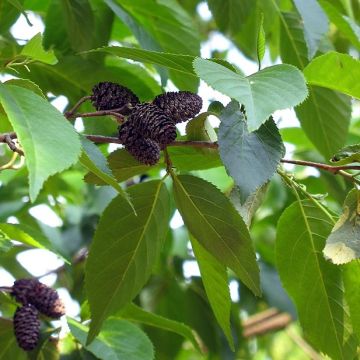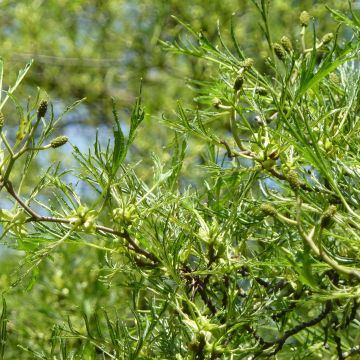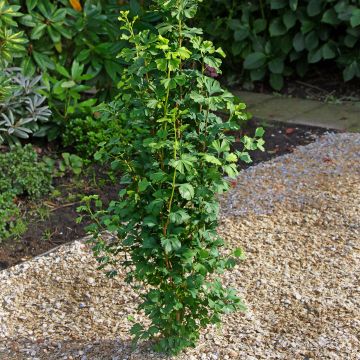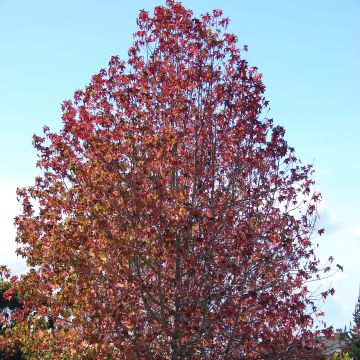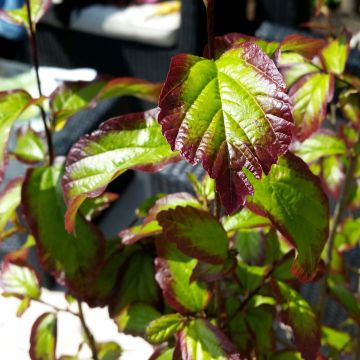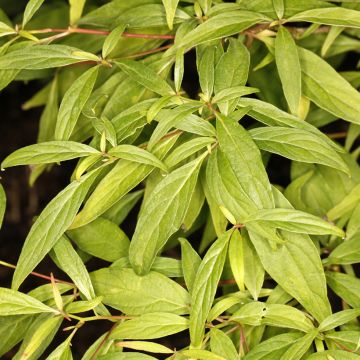

Alnus incana pendula- Grey Alder
Alnus incana pendula- Grey Alder
Alnus incana pendula
Grey Alder, Speckled Alder
This item cannot be shipped to the selected country
Oversize package delivery charge from €6.90
Delivery to Corse prohibited
More information
Schedule delivery date,
and select date in basket
This plant carries a 24 months recovery warranty
More information
We guarantee the quality of our plants for a full growing cycle, and will replace at our expense any plant that fails to recover under normal climatic and planting conditions.
Oversize package: home delivery by special carrier from €6.90 per order..
Express home delivery from €8.90.
Delivery to Corse prohibited: UE law prohibits the import of this plant from mainland France to Corse as part of the fight against Xylella fastidiosa. Please accept our sincere apologies.
More information
Does this plant fit my garden?
Set up your Plantfit profile →
Description
Alnus incana 'Pendula' is a beautiful weeping form of the white alder, a deciduous native tree that is very robust. This variety is smaller than the species. It develops a very straight, very light grey trunk, which gives rise to several branches that spread quite widely in graceful arcs, with secondary branches and branches that hang rather stiffly; given space, it makes a truly graceful landscape tree. It is noticeable from the end of winter, with its slightly tousled branches, adorned with purple and pendant catkins.
Alnus incana 'Pendula' was discovered in Poland at the end of the 19th century. It is a deciduous tree of the Betulaceae family, just like birch trees. The species, also known as mountain alder or grey alder, is native to temperate regions of the Northern Hemisphere and is hardy down to -36ºC. Thanks to its flexibility and ability to produce suckers, it is one of the few trees capable of withstanding avalanches. It is a pioneer, fast-growing species, capable of forming dense stands in poor, limestone soils. Its deep and spreading root system allows it to withstand wind and anchor itself firmly even in very unstable, sloping soil. The white alder thrives in limestone soils and adapts well to both wet and moderately dry soils in summer.
The 'Pendula' white alder reaches a height of 6 to 8 metres and a spread of 3 to 5 metres. Its growth rate is moderate and depends on the growing conditions. This variety develops a trunk that gives rise to arched main branches and a canopy with all parts trailing. The entire canopy resembles large green curtains. The trunk and young branches are light grey. The deciduous foliage appears in spring and falls in autumn. It is airy, light green, composed of spaced, oval leaves with coarse-toothed edges. The branches and the undersides of the leaves are covered in a light fuzz. The leaves are a fairly dark green and slightly glossy. They fall in autumn. The decorative flowering occurs in February. The tree bears inconspicuous female catkins, measuring about 5 cm long, and more decorative, violet male catkins, 7 cm long, with a powdery yellow pollen. After pollination by insects, the female flowers transform into fruits. These are grey-brown cones, visible from September onwards, remaining attached to the branches throughout winter. They release narrow-winged nuts that are dispersed by the wind and provide an important food source for certain birds.
Alnus incana 'Pendula' should be planted in an area sufficiently large enough for it to reach its full size and in a well-exposed location to enjoy its natural elegance. Plant violets or periwinkles at its base. Surround it with low-growing shrubs that appreciate limestone, such as St. John's wort, for example.
White alder is often planted to populate poor and unstable mountain soils, as well as on slag heaps. Its root system forms nodules containing bacteria that fix nitrogen from the air, returning this richness to the soil. It is also found in windbreak hedges in the plains.
Alnus incana comes from the Latin word incanus, which means "covered with grey-white hairs," referring to the hairy undersides of young leaves. The leaf is used as a diuretic and vermifuge. The bark is astringent and tonic.
Report an error about the product description
Plant habit
Flowering
Foliage
Safety measures
Botanical data
Alnus
incana
pendula
Betulaceae
Grey Alder, Speckled Alder
Alnus incana var. pendula
Cultivar or hybrid
atteinterespiratoire
Cette plante peut entraîner des symptômes allergiques.
Evitez de la planter si vous ou vos proches souffrez de rhinite saisonnière ("rhume des foins").
Davantage d'informations sur https://plantes-risque.info
Other Alnus - Alder
Planting and care
The easy-to-grow, hardy White Alder 'Pendula' requires little maintenance. Plant it in dry to moist soil, preferably limestone, in full sun. It tolerates wind well. Prune only to remove dead or unwanted branches.
Planting period
Intended location
Care
This item has not been reviewed yet - be the first to leave a review about it.
Trees and large shrubs
Haven't found what you were looking for?
Hardiness is the lowest winter temperature a plant can endure without suffering serious damage or even dying. However, hardiness is affected by location (a sheltered area, such as a patio), protection (winter cover) and soil type (hardiness is improved by well-drained soil).

Photo Sharing Terms & Conditions
In order to encourage gardeners to interact and share their experiences, Promesse de fleurs offers various media enabling content to be uploaded onto its Site - in particular via the ‘Photo sharing’ module.
The User agrees to refrain from:
- Posting any content that is illegal, prejudicial, insulting, racist, inciteful to hatred, revisionist, contrary to public decency, that infringes on privacy or on the privacy rights of third parties, in particular the publicity rights of persons and goods, intellectual property rights, or the right to privacy.
- Submitting content on behalf of a third party;
- Impersonate the identity of a third party and/or publish any personal information about a third party;
In general, the User undertakes to refrain from any unethical behaviour.
All Content (in particular text, comments, files, images, photos, videos, creative works, etc.), which may be subject to property or intellectual property rights, image or other private rights, shall remain the property of the User, subject to the limited rights granted by the terms of the licence granted by Promesse de fleurs as stated below. Users are at liberty to publish or not to publish such Content on the Site, notably via the ‘Photo Sharing’ facility, and accept that this Content shall be made public and freely accessible, notably on the Internet.
Users further acknowledge, undertake to have ,and guarantee that they hold all necessary rights and permissions to publish such material on the Site, in particular with regard to the legislation in force pertaining to any privacy, property, intellectual property, image, or contractual rights, or rights of any other nature. By publishing such Content on the Site, Users acknowledge accepting full liability as publishers of the Content within the meaning of the law, and grant Promesse de fleurs, free of charge, an inclusive, worldwide licence for the said Content for the entire duration of its publication, including all reproduction, representation, up/downloading, displaying, performing, transmission, and storage rights.
Users also grant permission for their name to be linked to the Content and accept that this link may not always be made available.
By engaging in posting material, Users consent to their Content becoming automatically accessible on the Internet, in particular on other sites and/or blogs and/or web pages of the Promesse de fleurs site, including in particular social pages and the Promesse de fleurs catalogue.
Users may secure the removal of entrusted content free of charge by issuing a simple request via our contact form.
The flowering period indicated on our website applies to countries and regions located in USDA zone 8 (France, the United Kingdom, Ireland, the Netherlands, etc.)
It will vary according to where you live:
- In zones 9 to 10 (Italy, Spain, Greece, etc.), flowering will occur about 2 to 4 weeks earlier.
- In zones 6 to 7 (Germany, Poland, Slovenia, and lower mountainous regions), flowering will be delayed by 2 to 3 weeks.
- In zone 5 (Central Europe, Scandinavia), blooming will be delayed by 3 to 5 weeks.
In temperate climates, pruning of spring-flowering shrubs (forsythia, spireas, etc.) should be done just after flowering.
Pruning of summer-flowering shrubs (Indian Lilac, Perovskia, etc.) can be done in winter or spring.
In cold regions as well as with frost-sensitive plants, avoid pruning too early when severe frosts may still occur.
The planting period indicated on our website applies to countries and regions located in USDA zone 8 (France, United Kingdom, Ireland, Netherlands).
It will vary according to where you live:
- In Mediterranean zones (Marseille, Madrid, Milan, etc.), autumn and winter are the best planting periods.
- In continental zones (Strasbourg, Munich, Vienna, etc.), delay planting by 2 to 3 weeks in spring and bring it forward by 2 to 4 weeks in autumn.
- In mountainous regions (the Alps, Pyrenees, Carpathians, etc.), it is best to plant in late spring (May-June) or late summer (August-September).
The harvesting period indicated on our website applies to countries and regions in USDA zone 8 (France, England, Ireland, the Netherlands).
In colder areas (Scandinavia, Poland, Austria...) fruit and vegetable harvests are likely to be delayed by 3-4 weeks.
In warmer areas (Italy, Spain, Greece, etc.), harvesting will probably take place earlier, depending on weather conditions.
The sowing periods indicated on our website apply to countries and regions within USDA Zone 8 (France, UK, Ireland, Netherlands).
In colder areas (Scandinavia, Poland, Austria...), delay any outdoor sowing by 3-4 weeks, or sow under glass.
In warmer climes (Italy, Spain, Greece, etc.), bring outdoor sowing forward by a few weeks.


































